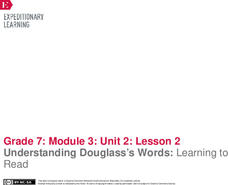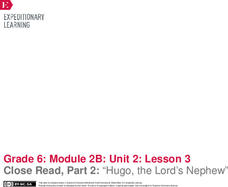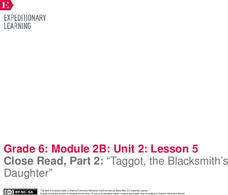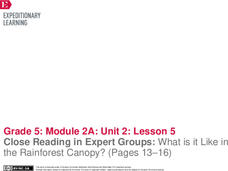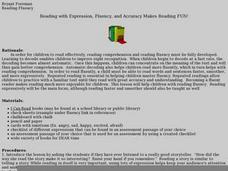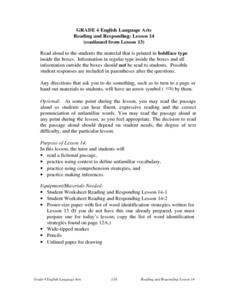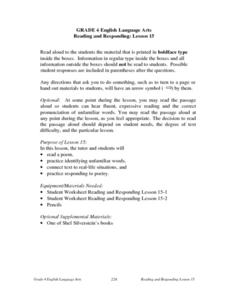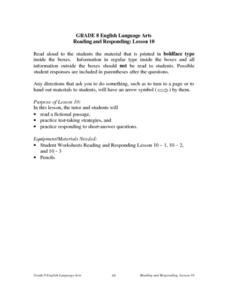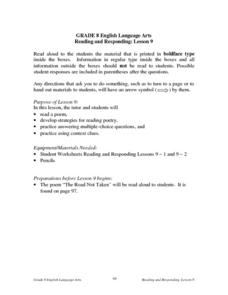EngageNY
Understanding Douglass’s Words: Learning to Read
How is a sentence like the human body? Scholars think about the comparison as they view an image of the human anatomy and begin to complete an Anatomy of a Sentence anchor chart. They review roots, prefixes, and suffixes and then begin...
Center for the Advancement of Ethics and Character
Charlotte's Web: A Story About Friendship
Strengthen the bonds of friendship within your class with a reading of E.B. White's award-winning novel, Charlotte's Web. Focusing on the unique characters in the story and the relationships they develop, young readers draw...
EngageNY
Analyzing Powerful Language: Learning to Read
The power of a word. Readers learn the importance of word choice in shaping a text by using a Powerful Language T-chart to separate strong words and phrases from those that are more bland. They then complete a third read and question set...
EngageNY
Close Read, Part 2: “Hugo, the Lord’s Nephew”
No, not literally. Scholars read Hugo, the Lord’s Nephew to compare figurative and literal language. Readers learn about simile, metaphor, personification, and idioms with a graphic organizer. Pupils then answer text-dependent...
EngageNY
Reading for Gist and Answering Text-Dependent Questions: Chapter 5 of World without Fish
Discover the rules of fishing. Pupils read chapter five of World without Fish to discover ideas about the rules and laws of fishing. They use sticky notes to annotate text as they read about fishing in other countries. They focus on...
Texas Education Agency (TEA)
Imagery (English III Reading)
Picture this! The first interactive in a set of 13 shows learners how writers use imagery and sensory details to create mental pictures in readers' minds.
Curated OER
First Grade Reading: Sight Words
Introduce your first graders to 10 new sight words with this vibrant PowerPoint. Words include: always, because, call, and more! Each word is on its own slide with a corresponding picture and an example sentence. Tip: After teaching...
Curated OER
Reading Functional Weather Sight Words
Sight words, word recognition, and flash card drills are the mode for teaching that is outlined here. To increase weather vocabulary and content specific word recognition, kids with special needs work through flash card drills. The...
Curated OER
Reading: Classroom Words
There are 10 classroom words located at the top of this instructional activity. Kindergartners match the word to the object in the picture, they write that word on the line near that object. This is a great way for them to recognize...
Curated OER
Reading Comprehension Strategy: Using Background Knowledge
The value of this presentation is that it not only defines background knowledge but includes exercises that show readers how to activate and use what they already know about a topic to make text-to-self, text-to-text, and text-to-world...
EngageNY
Launching To Kill A Mockingbird: Establishing Reading Routines (Chapter 1)
Scholars use a Story Impressions Note-catcher to capture their first impressions of words or phrases from To Kill a Mockingbird. They then listen to a reading of the first six pages of the novel before the teacher asks questions to check...
EngageNY
Performance Task: Two-Voice Poem Readings
Eye contact, volume, and pronunciation are key ingredients to a successful presentation. Pupils present their two-voice poems to the class with their poetry reading partners. Next, to wrap up the unit, scholars use a worksheet to reflect...
EngageNY
Reading More Closely: Inferences and Evidence in Pygmalion
Learners read in section five of Pygmalion about Eliza's words and actions that shock the Victorian crowd. They answer text-dependent questions about the section, and then work with partners to add more details to their Eliza Character...
EngageNY
Gathering Information about Water Management: Assessing and Reading Internet Sources, Day 3
Water is life! Using the informative resource, scholars first read two informational articles about water management in agriculture. Then, they use a Venn diagram to contrast the different types of evidence authors use to support a...
EngageNY
Exploring Allusions to Myths in The Lightning Thief: Close Reading Part 1 of “Prometheus”
It's all just an allusion. Scholars learn the meaning of allusion and read an allusion in The Lightning Thief. Learners gather in their triads and discuss questions from the text to take a close look at vocabulary words and choose...
EngageNY
Close Read, Part 2: “Taggot, the Blacksmith’s Daughter”
It is just a figure of speech. Readers look for figurative language as they read Taggot, the Blacksmith’s Daughter. They complete a Figurative Language graphic organizer by recording and identifying the types of figurative...
EngageNY
Close Reading in Expert Groups: What is it Like in the Rainforest Canopy? (Pages 13–16)
Put it together piece by piece. Scholars read pages 13-16 of The Most Beautiful Roof in the
World by dividing it into chunks. They analyze each chunk for gist and word meaning. Individuals then create a matching game by writing...
Curated OER
Extra, Extra Read All About It
Looking for an interactive roll playing lesson? Young actors practice reading and rereading decodable texts with expression. They interact with the play, "The Boy Who Wanted the Willies," by Aaron Shepherd within this lesson. An...
Curated OER
Reading With Expression, Fluency, And Accuracy Makes Reading Fun!
Young scholars observe and demonstrate a variety of reading expression strategies. They listen to the teacher read different sentences with and without expression and discuss the difference, then in pairs read an "I Can Read" book using...
Curated OER
Poetry Shared Reading
Students explore poetry. For this poetry lesson, students discover the qualities of good writing and the characteristics of poetry. Students practice reading poems in different ways. Studnets also discuss the mood of the poem and the...
Curated OER
Reading and Responding -- Lesson 14
Fourth graders work independently or in a small group to (1) read a fictional passage, (2) use context clues to define unfamiliar vocabulary, (3) use comprehension strategies, and (4) make inferences. Reading passages and comprehension...
Curated OER
Reading and Responding -- Lesson 15
Fourth graders work independently or in a small group to (1) read a poem, (2) identify unfamiliar words, (3) connect text to real-life situations, and (4) respond to poetry. Reading passage, comprehension questions, and teacher script...
Curated OER
Reading and Responding -- Lesson 10
Fourth graders work individually or in a small group to (1) read a fictional passage, (2) practice test-taking strategies, and (3) practice using context clues to increase their vocabulary. Reading passage and comprehension questions...
Curated OER
Reading and Responding -- Lesson 9
Fourth graders work independently or in a small group with a tutor or teacher to (1) read a nonfictional selection, (2) practice drawing conclusions, (3) identify main ideas, and (4) practice responding to cause and effect questions.
Other popular searches
- Reading Comprehension
- Fluency
- Guided Reading
- Reading Fluency
- Reading Fluency Passages
- Reading Strategies
- Shared Reading
- Reading Fluency Games
- Choral Reading
- Guided Reading Comprehension
- Reading Comprehension Skills
- Map Reading
